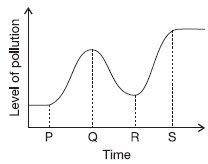Subject :NSO Class : Class 7
Class : Class 7
yep it should be B . check your description its wrong . metal expands on heating and vice versa. plz help me with my questions too
Subject :NSO Class : Class 5
Ans 6:
Class : Class 9
B and C both are correct. Wolf is a carnivore. But in solution they have given 'Jackal'. SOF requesting you to either 1. Change the word 'Jackal' to 'Wolf' in solution and then change option D to 'Both B and C' OR 2. Change 'Wolf' in Option C to 'Jackal'. Pls. change according to any one of the points above ASAP to avoid confusion.
Ans 8:
Class : Class 5
but the tiger is as same as the wolf as both are carnivores there diet includes mulsk , deerelk and bison means they are carnivores
Ans 14:
Class : Class 10
ITS TRUE THAT HUMANS AND CROWS ARE OMNIVORES BUT TIGERS AND WOLVES ARE CARNIVORES ....
Ans 17:
Class : Class 9
actually people mis understand it wolf is not a carnivores it is a scavenger they dont hunt usually they find or steal from the carnivores hence tiger and wolf is not the same
Ans 19:
Class : Class 6
more or less both tiger and wolf and man and crow have same eating habits if it is in the form of carnivores, herbivores and omnivores. but strictly speaking crow can eat things man can't.
Ans 21:
Post Your Answer
Subject :NSO Class : Class 8
Post Your Answer
Subject :NSO Class : Class 10
Post Your Answer
Subject :NSO Class : Class 4
Ans 10:
Class : Class 4
But why not D? If trees were cut down at point P, then why is the point at lowest pollution?
Ans 13:
Class : Class 5
The answer cannot be B because the timeline Q-R is a decrease in pollution whereas if a factory was set up in point Q.Q-R would be an increase of pollution and not a decrease.In point P trees were cut and because of that P-Q is an increase in pollution and not a decrease .So,the answer is not B but A.
Post Your Answer
Subject :NSO Class : Class 8
Ans 1:
Class : Class 8
In my opinion, the answer should be option (A) instead of option (B). On the Richter scale (which is a non-linear scale), the power of an earthquake increases by 10 with every consequent number. Thus, an earthquake of 2 on the Richter scale is 10 times more powerful than an earthquake of 1 on the Richter scale. Thus, an earthquake of 8 on the Richter scale is more powerful than an earthquake of 6 on the Richter scale, by a factor of 10⁸⁻⁶, or 10². Thus, an earthquake of 8 on the Richter scale is 100 times more powerful than an earthquake of 6 on the Richter scale.
Ans 2:
Class : Class 9
Hi friend. The ans is (A) 100 because on richter scale the magnitude is increased ten times every number. for example 2 is 10 times 1 on richter scale.
Post Your Answer
Subject :NSO Class : Class 4
Post Your Answer
Subject :NSO Class : Class 4
Post Your Answer
Subject :NSO Class : Class 8
Ans 1:
Class : Class 8
The answer is D. If wavelength changes , then frequency and time period will also change. Wavelength is inversely propotional to frequency and directly propotional to time period.
Ans 10:
Class : Class 8
The correct answer should be D. Because temperature of air increases, density decreases and so, frequency of sound increases. But, according to me, it may or may not affect the wavelength, but the time period will definitely decrease. The options are a bit confusing.....
Ans 13:
Class : Class 8
It should be answer D. If wavelength changes, frequency and time period will also change.
Ans 14:
Class : Class 9
no it can not be option d as temperature has no effect on frequency. Wheather temperature increases or decreases frequency remains unchanged. So, the answer could be either time period or frequency.
Post Your Answer
Subject :NSO Class : Class 7



